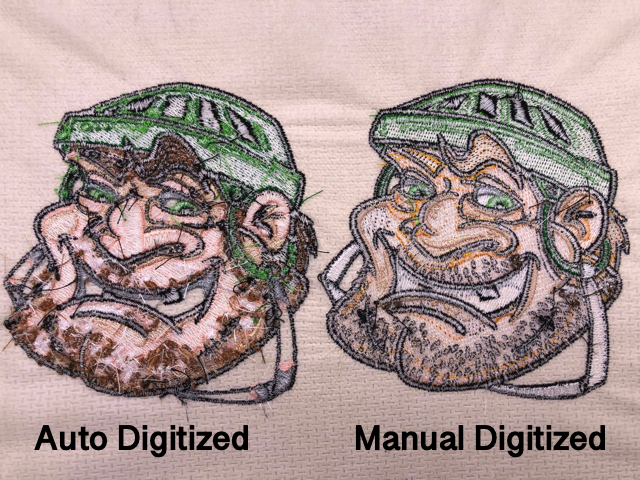Professional Digitizing for Embroidery: High-Quality Layouts
Professional Digitizing for Embroidery: High-Quality Layouts
Blog Article
Grasping the Needlework Digitizing Refine: Your Ultimate Guide
Embroidery digitizing is a careful craft that calls for accuracy and knowledge to convert intricate layouts right into digital styles for machine embroidery. As artisans get started on this trip to master the embroidery digitizing procedure, a comprehensive understanding of the fundamentals establishes the structure for quality.

Comprehending Embroidery Digitizing Essentials
Embroidery digitizing fundamentals create the foundation upon which complex designs are translated into machine-readable styles for exact sewing. This preliminary action in the embroidery digitizing procedure is essential for guaranteeing that the final embroidered product is a faithful depiction of the initial style. Recognizing embroidery digitizing basics entails comprehending crucial concepts such as stitch types, sew instructions, thickness, padding, and draw payment.
Sew kinds play a vital role in establishing the aesthetic and textural end result of the embroidered design. By selecting the appropriate stitch type, whether it be satin, fill, or running stitch, digitizers can achieve the desired effect and enhance the general high quality of the embroidery. Furthermore, stitch instructions influences the flow and measurement of the style, while density figures out the spacing and protection of the stitches.
Furthermore, padding stitching provides security to the layout by safeguarding the fabric and preventing distortion during the needlework procedure. Pull compensation is another essential factor to consider to counteract the all-natural propensity of textile to agreement when sewn. Mastering these needlework digitizing essentials is fundamental for creating professional-quality embroidered products.
Choosing the Right Digitizing Software Application
Picking the appropriate digitizing software is an important decision that considerably impacts the efficiency and quality of the needlework digitizing process. Digitizing for Embroidery. When picking the appropriate digitizing software application, it is essential to take into consideration elements such as the intricacy of styles you plan to create, the user-friendliness of the software, the degree of consumer assistance used, and the compatibility with your needlework maker
There are numerous digitizing software alternatives offered on the market, ranging from basic programs for newbies to sophisticated software for expert digitizers. Some popular selections consist of Wilcom EmbroideryStudio, Hatch Embroidery Software, and PulseID. These software plans offer a variety of devices and functions to assist you create elaborate layouts easily.
Prior to deciding, it is suggested to explore the different software program options with cost-free trials or trials to determine which one finest fits your check over here demands. In addition, reviewing testimonials and seeking suggestions from seasoned digitizers can provide useful insights into the strengths and weak points of each software plan (Digitizing for Embroidery). By carefully examining your needs and contrasting the attributes of different digitizing software program, you can make an enlightened selection that enhances your embroidery digitizing process
Digitizing Tools and Strategies

Optimizing Layout Setup for Embroidery
Mastering the details of layout setups is fundamental in attaining ideal outcomes in the embroidery digitizing procedure, structure upon the structure laid by understanding digitizing devices and strategies. When optimizing style settings for embroidery, it is necessary to take into consideration elements such as stitch type, thickness, underlay, pull compensation, and enrollment. Enrollment setups align various aspects of the style precisely, preserving overall style integrity.

Troubleshooting Common Digitizing Issues
When running into typical digitizing problems during the embroidery process, it is important to recognize the origin and execute reliable options quickly. One typical issue is stitch density problems, where stitches may be too why not try this out thick, causing the fabric to pucker, or as well sparse, causing spaces in the style. Readjusting the stitch density settings in the digitizing software application can help fix this problem.
Another regular challenge is string breaks during the embroidery procedure. This can take place due to numerous factors such as inaccurate tension setups, boring needles, or making use of low-grade string. Making certain appropriate upkeep of the needlework device, including normal needle changes and stress adjustments, can reduce the occurrence of thread breaks.
Additionally, design registration errors can result in misaligned aspects within the embroidery style. Inspecting the design alignment in the digitizing software and making essential changes prior to stitching can aid in avoiding this concern. By resolving these common digitizing concerns without delay and successfully, you can guarantee a smoother needlework process and high-quality completed products.
Final Thought
To conclude, understanding the embroidery digitizing process needs a strong understanding of the fundamentals, the ideal selection of software, and knowledge of tools and techniques. Optimizing style setups and repairing typical digitizing important link concerns are important steps in guaranteeing high-quality embroidery outcomes. By adhering to these actions carefully, one can achieve accuracy and effectiveness in the digitizing procedure.
Report this page